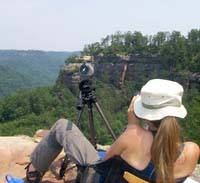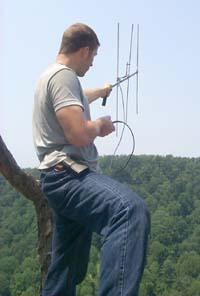Peregrine Falcon Flying High Over Red River Gorge
Peregrine Falcon Flying High Over Red River Gorge

Once a common sight in the cliffs of the Kentucky Appalachians, the peregrine falcon slowly disappeared by the 1960s. Eventually it was listed as an endangered species. University of Kentucky wildlife management specialists in the College of Agriculture have been working hard to reestablish the bird of prey in the Red River Gorge area over the last three years.
“The use of pesticides, especially DDT, was the main reason for the decline in peregrine falcon numbers,” said Mike Lacki, UK wildlife and ecology management specialist. “The pesticides worked their way through the food chain and eventually into the falcon’s prey which crippled the reproduction of not only the peregrine, but many other raptor species.”
 Lacki said populations of falcons then declined to such low levels they were considered endangered. Since that time there have been extensive efforts throughout the United States to bring the bird back and it now is delisted, but the work is not finished. Many areas, including Kentucky, have not seen a resurgence to this point. Much of the restoration efforts are accomplished through a process called hacking.
Lacki said populations of falcons then declined to such low levels they were considered endangered. Since that time there have been extensive efforts throughout the United States to bring the bird back and it now is delisted, but the work is not finished. Many areas, including Kentucky, have not seen a resurgence to this point. Much of the restoration efforts are accomplished through a process called hacking.
Hacking is a process in which birds are hatched in captivity and then maintained and fed until they are 30 to 35 days old. At that point, the falcons are transported to a site where they are fed within a containment box for another set of days, depending on each bird’s needs and when they are ready to take flight. The birds are then released and the amount of food provided gradually is decreased.
About five or six years ago, Kentucky began participating in the recovery effort. Lacki said the Commonwealth, like many other states, tried to reintroduce the falcon in urban areas but was largely unsuccessful.
“Our phase of the project began at UK three years ago and was implemented to see if we could have some success in restoring the falcons in more natural environments instead of relying on human-made habitats,” Lacki said. “The first summer was spent inventorying the landscape in various parts of the state to find suitable habitats for the birds’ needs. Since that time, we identified the region in and around the Red River Gorge for a variety of reasons.”
Last summer, Lacki and two graduate students, Matt Dzialak and Tina LaDeur, began hacking birds in the gorge. Before the birds are released, they are banded for identification purposes. The birds also wear small devices so Dzialak can track their location with a battery operated transmitter attached to an antenna. LaDeur spends a lot of time sitting on a cliff observing the birds through binoculars and a telescope to study their behavior patterns.
“We can track the birds through the first several months, but the transmitters have a limited life span, so there comes a time when the batteries wear out and our ability to track them ends,” Lacki said. “The birds are banded so that if they do return and if we can get them in view with a spotting scope, we can identify them as birds we released or birds that were released by someone else. These birds move fast and cover a lot of ground and it’s real difficult to keep track of them.”
Peregrine falcons have been known to reach speeds of 250 mph. They can power dive to catch their prey in the air.
Dzialak began working with the peregrine restoration project early in 2000. He said he’s interested in restoring native bird species to natural habitats, primarily those species with “sharp teeth and claws.”
“In Kentucky hacking hasn’t been done in habitats like this. My goal is to follow the birds and learn from them and then see how this research applies to other areas of the country as well,” he said. “This project is both an applied effort in species conservation, as well as a research effort. One goal is to restore the peregrine falcon as a breeding species. The other goal is to learn why the peregrine falcons have been slow to recolonize areas like this.”
During the hacking process, Dzialak has tried to limit human interaction with the falcons as much as possible so the birds remain wild.
“We want the falcons to have an aversion to humans; to be like wild animals are. And generally wild animals want to avoid humans,” he said. “We feed them without them seeing us; we care for them without them recognizing it’s people who are caring for them so they are able to survive in the wild.”
He also said that once the birds begin to fly around and feel comfortable with their new surroundings he won’t be able to track them from the cliffs because they will travel too far and too fast. To compensate, Dzialak will follow them in an airplane and attempt to study their movement that way.
Lacki, Dzialak and LaDeur plan to continue the restoration effort until the end of the 2003 summer.
“Our hope is that at least a few of these birds pair up and make their way back here in the future, so a bird that was native to this state will be restored.” Lacki said.
